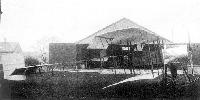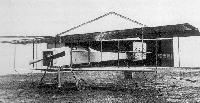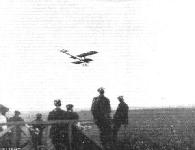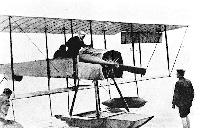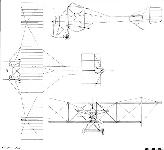
Описание
Страна: Великобритания
Год: 1912
Варианты
- Short - S.36 / S.45 tractor biplane - 1912 - Великобритания
- Short - S.41 seaplane - 1912 - Великобритания
- Short - S.68 - 1913 - Великобритания
- Short - Type 74 / Type 81 Folder - 1913 - Великобритания
- Short - Type 135 / Type 136 - 1914 - Великобритания
- C.Barnes Short Aircraft since 1900 (Putnam)
- M.Goodall, A.Tagg British Aircraft before the Great War (Schiffer)
- P.Lewis British Aircraft 1809-1914 (Putnam)
- O.Thetford British Naval Aircraft since 1912 (Putnam)
- Jane's All The World Aircraft 1913
- Журнал Flight
-
M.Goodall, A.Tagg - British Aircraft before the Great War /Schiffer/
Short S.36 as originally built with open rear fuselage. The basis for a succession of tractor biplanes was built for McClean in 1911 and followed the abandoned S.32 for the late Cecil Grace.
-
Журнал - Flight за 1912 г.
The Short tractor biplane, constructed by Messrs. Short Bros, for Mr. Frank K. McCiean, which has been doing successful work at Eastchurch recently.
-
Jane's All The World Aircraft 1913 /Jane's/
Old 1911-12 Tractor biplane.
-
P.Lewis - British Aircraft 1809-1914 /Putnam/
Prototype Short T.5 in January, 1912, with Capt. E. L. Gerrard in the front cockpit and Oswald Short in the rear.
-
C.Barnes - Short Aircraft since 1900 /Putnam/
Mr. Frank McClean in the pilot's seat of his 70-h.p. Short tractor machine, with Miss McClean as passenger, prior to a flight at eastchurch.
Frank McClean and his sister Anna in S.36 at Eastchurch in 1912; the rear fuselage has been covered and set lower relative to the wings. -
Журнал - Flight за 1912 г.
A near view of Mr. McClean's 70-h.p. Short tractor machine ready for a flight. With Mr. McClean is Miss Lucas as passenger.
-
Журнал - Flight за 1912 г.
Lieut. Spencer Grey, R.N., with Assistant Paymaster Frewin, R.N., on the new naval 70-h.p. Short tractor biplane at the Royal Aero Club's Eastchurch flying ground.
-
C.Barnes - Short Aircraft since 1900 /Putnam/
S.49 at Eastchurch in January 1913 before delivery to the Central Flying School.
-
M.Goodall, A.Tagg - British Aircraft before the Great War /Schiffer/
Short S.51 went to CFS as No.424 in 1912. S.45 and S.50 were similar machines.
-
P.Lewis - British Aircraft 1809-1914 /Putnam/
Short T.5, flown by Lt. S. D. A. Grey, taking-off at Margate on 30th May, 1912.
-
Журнал - Flight за 1912 г.
Mr. Frank McClean in flight at the Royal Aero Club's Eastchurch flying grounds on his Short tractor biplane.
-
Журнал - Flight за 1912 г.
Mr. Frank McClean making a vol plane on his 70-h.p. Short tractor at the Royal Aero Club's Eastchurch flying grounds.
-
Журнал - Flight за 1913 г.
Commander Samson flying a Short biplane at Eastchurch.
-
P.Lewis - British Aircraft 1809-1914 /Putnam/
Short T.5 with single float.
-
M.Goodall, A.Tagg - British Aircraft before the Great War /Schiffer/
Short S.45 (RNAS Nos.T.5 and 5) as a central float seaplane.
-
C.Barnes - Short Aircraft since 1900 /Putnam/
S.45 at Portsmouth during the Naval Review in July 1912.
-
C.Barnes - Short Aircraft since 1900 /Putnam/
S.45 being beached at Eastney on 5 July, 1912, after being flown from Sheerness by Lieuts Spenser Grey and Sheppard.
-
C.Barnes - Short Aircraft since 1900 /Putnam/
S.45, with revised wings and cockpit coaming, at Carlingnose in October 1912 shortly before capsizing.
-
Jane's All The World Aircraft 1913 /Jane's/
Short S.45 type.
C.Barnes Short Aircraft since 1900 (Putnam)
Short Tractor Biplanes (1910-12)
After flying a Bleriot monoplane at the Blackpool meeting in 1910, Cecil Grace asked Horace Short to consider developing a tractor biplane having a comparable performance, and work was begun in December on a tractor version of the S.27-type, with a 60 hp E.N.V. engine, allotted works No. S.32. Then Grace had flown to his death in the de Forest contest and S.32 was completed as a normal pusher training biplane. From January to July 1911 Frank McClean was absent from Eastchurch on the Fiji eclipse expedition, but on his return Horace Short showed him a revised design for a 70 hp Gnome-engined tractor biplane, and McClean ordered one for his private use. Details of the geometry were discussed at some length, and Horace Short insisted that the thrust and drag should be made to coincide so as to minimise change of trim with engine on or off, using a flat tailplane, so he located the fuselage midway between the wings. The biplane, S.36, was finished late in 1911, and McClean flew it for the first time, very successfully, on 10 January, 1912.
As built, S.36 had standard two-bay wings with strut-braced extensions on the upper wing and no bottom ailerons. The middle bay struts embraced the fuselage sides and there was a central gap in the lower wing. The fuselage was a simple square-section wire-braced girder of four straight longerons, converging slightly from nose to tail, with plywood covering along the sides of the two tandem cockpits and aluminium panels enclosing the tanks and overhung engine mounting; a simple twin-skid chassis, with two wheels on a rubber-sprung cross-axle, was carried by the bottom longerons between the wing leading edge and the engine front bracket. The non-lifting tailplane carried divided elevators, and a partly balanced rectangular rudder was hinged to the vertical sternpost; there was a sprung trailing tailskid, and the rear fuselage was at first left uncovered, as in the Bleriot monoplane. With a 9-ft airscrew, S.36 had a quick take-off and a speed of 60 mph. McClean immediately lent it to the Naval Flying School, and on 11 March, 1912, Lieut Longmore, with his mechanic, E. R. A. O’Connor, as passenger, flew it 172 miles in four hours, thereby winning the Royal Navy Mortimer Singer prize of £500.
<...>
Meanwhile the second Naval tractor biplane, S.45, had been completed and, profiting from Samson’s experience with S.41, both S.45 and McClean’s S.36 had their fuselages rigged lower, so as to increase wing-tip ground clearance; at this stage both had their rear fuselages covered with fabric, to increase directional stability, particularly necessary if floats were to be fitted. S.45 had two fewer ribs in each wing than S.36, so that its span was slightly less and the ailerons were set farther inboard. The extension struts were attached to the top end ribs of S.45, which was almost the only visible difference from S.36 after the fuselage modifications. S.45 was first flown as a landplane by Lieut Spenser Grey on 24 May, 1912, and he twice flew to Margate and back with Lieut Sheppard as passenger on 30 and 31 May. On acceptance, S.45 received the serial T5 and continued to carry this even after conversion to a seaplane, when officially the serial should have become H5.
On 3 June, 1912, having had an engine overhaul, S.41 was flown by Samson from Burntwick Island, Sheerness, to Harwich, to explore the Orwell and Stour estuaries and decide on the best site for a new seaplane station; after inspecting Shotley and Mistley, Samson recommended the Suffolk shore between Felixstowe Dock and Landguard Point, and this was how the Felixstowe Air Station, afterwards for so many years the home of the Marine Aircraft Experimental Establishment, originated. Samson flew back to Sheerness without incident on 14 June and then supervised the installation of a float chassis on S.45, which was in the works being repaired after a forced landing in fog. S.45 was given a single central pontoon, again with no step, and was stabilised at rest by two streamlined air-bags set low under the inner pair of wing struts. The main float was long enough to keep the seaplane’s tail clear of the water, and the original tailskid was left in situ, but later an air-bag was packed close under the rear fuselage to prevent the tail being submerged while on tow. When tested at the end of June by Samson, S.45 reached 62 mph as a seaplane, while carrying a passenger.
During this time McClean had been engaged in a maritime exercise of his own in S.36. On 17 June he flew to Eastbourne to attempt to photograph the submerged wreck of the P & O liner Oceana, which had sunk off Beachy Head. After a few trial runs he took off on 21 June with photographer Charles Cusden of The Sphere in the rear cockpit and made successive passes over the wreck at 900 ft, 700 ft, 500 ft and finally 300 ft; in the last run his airscrew picked up a little blown spray but was not damaged. He started home on 2 July, but flew into rain and fog, so he landed at his family home near Tunbridge Wells, the biplane returning to Eastchurch by road. The wings were found to be so waterlogged that they had to be renewed, but McClean was flying S.36 again by 21 July.
Both S.41 and S.45 were flown to Portsmouth for the Naval Review in July. Samson, flying solo in S.41, covered the 194 miles round the coast from Eastchurch to Eastney in 195 minutes, most of the way at 2,000 ft. Spenser Grey and Sheppard on S.45 had to alight at Newhaven for engine adjustments, but were not much delayed. Both flew over the Fleet on 9 July, and on 13 July Samson flew S.41 back to Dover, moored in the harbour overnight and, with E. R. A. O’Connor as passenger, flew on to Harwich next day, a total distance of 250 miles. On the strength of these performances, the Admiralty ordered two more 100 hp Gnome tractor seaplanes, with minor improvements but substantially similar to S.41. The 70 hp seaplane was not so successful, and on 25 July reappeared on wheels, when Spenser Grey flew it to Dover, returning to Eastchurch next day. Although its single-row engine was reliable by current standards, its single float made it difficult to handle on the water.
<...>
On returning to Sheerness from Harwich on 27 August, after another of Samson’s coastal survey flights, S.41 was converted to a landplane for participation in the Army autumn manoeuvres in East Anglia. All three of the Naval Short tractors took part, Samson on S.41 setting out first on 5 September, but having to land near Bishop’s Stortford with engine trouble. Malone left Eastchurch in S.47 on 7 September and arrived before Samson at the rendezvous at Hardwicke, near Cambridge; finally, Gordon flew S.45 to Hardwicke on the 13th, and all three returned to Eastchurch on the 20th. The Triple-Tractor then went into the works for overhaul and the other two for modification and reconversion to seaplanes. S.41 emerged with little visible change except that its wings could now be folded back alongside the fuselage to economise deck or hangar space; the gaps in the upper and lower centreplanes were filled in and the rudder carried the new serial 10. S.45, however, was more drastically altered; the wings did not fold, but now had compensated ailerons acting up as well as down, and the extensions were braced by wires and kingposts instead of struts. The floats were unchanged, but the engine cowling was square-framed at the front, continuing the line of the fuselage longerons, with local bulges in the panels to afford clearance for the engine; a faired coaming was added to the top decking around the two cockpits, and the rudder carried the simplified serial 5. In this form S.45 became the prototype of three similar landplanes with dual controls (S.48-50), ordered by the War Office for use at the newly established Central Flying School at Upavon on Salisbury Plain. Both S.41 and S.45 were shipped to Carlingnose, near Rosyth on the Firth of Forth, which was opened as a temporary Naval Air Station on 2 October; it was not a good location for a seaplane base, and on 4 October, 5 capsized on landing after a flight by Lieut Gordon; it was towed ashore for repairs, but is not recorded as having flown again.
On 10 October Capt Gerrard ferried S.48, serial 413, from Farnborough to Upavon, and it was flown on each of the next two days by Capt J. M. Salmond, who found it rather underpowered by C.F.S. standards. Nevertheless, it was flown fairly regularly, and on 28 November Lieut Smith Barry took it up to 7,000 ft, but this minor triumph was short-lived, for on 3 December Lieut Hubbard, with a passenger, stalled while approaching to land and wrecked it completely, though without injury to themselves. The other two S.45s already ordered arrived at Upavon in February 1913; Gerrard ferried 424 from Farnborough on the 17th in a gale and, after a good landing in difficult conditions, had the misfortune to be over-turned by a gust while taxying in; he was luckier when he brought in 423 on 22 February, and this was used for instruction for about a month, but then disappears from the record. Then, to the surprise and confusion of historians, both 423 and 424 returned to service in the spring of 1914, but had become B.E.8s! This was an example of a trick of War Office accounting which permitted the identity of an aeroplane to be vested in its original engine, regardless of the extent of ‘repairs’ made to its airframe, and was a subterfuge to which Col Seely resorted to avert a scandal when called to account in Parliament by Joynson-Hicks and other M.P.s over the alleged deficiency of serviceable aircraft available to the Royal Flying Corps. The two Short tractors, 423 and 424, having donated their identities and Gnome engines to two new Royal Aircraft Factory-built B.E.8 airframes, became surplus to War Office requirements; they were transferred to the Admiralty in August 1914 and, repaired and re-engined with 100 hp Clerget rotaries, flew again at Eastchurch as 1268 and 1219. No more Short tractor biplanes were built primarily as landplanes until the Bombers of 1915-16, and for the remaining years of peace all new Short designs were seaplanes.
S.36 - Span 46 ft 5 in (141 m); length 35 ft 6 in (10-8 m); area 515 sq ft (47-9 m2); empty weight 850 lb (380 kg); loaded weight, 1,300 lb (590 kg); speed 60 mph (96-6 km/h).
S.45, S.48-50 - Span 42 ft (12-8 m); length 35 ft 6 in (10-8 m); area 450 sq ft (41-8 m2); empty weight 1,080 lb (490 kg); loaded weight 1,500 lb (680 kg); speed 60 mph (96-6 km/h).
Описание:

